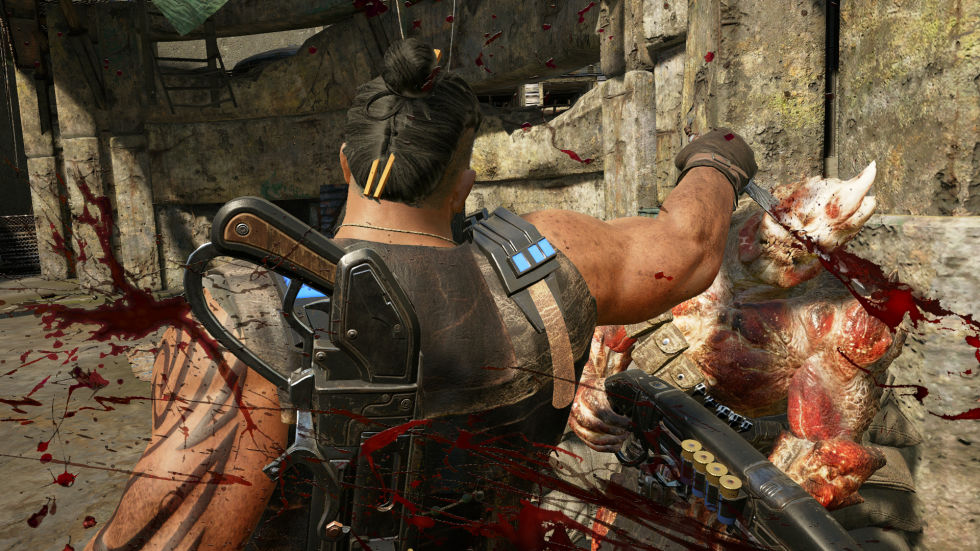COLOGNE, Germany—Changing the formula of a respected, successful franchise is a risky business, and first impressions of Gears of War 4's DeeBees highlight the problem. This new robotic race of enemies, seemingly named by the director of a children's television show, flank and shoot like the Locust we're used to, but the aesthetic difference is difficult to warm to. Shooting and killing sentient boxes of circuit boards and wires doesn't provide that same sense of guttural, crass satisfaction that comes with blasting a hole through the head of a Locust (which appear in other parts of the game), or ripping a chainsaw through its torso. Call me an animal, but that's what I want from Gears of War, the quintessential third-person cover-based shooter. Dismembering an android incarnation of The Rock doesn't provide that same splat and release.
Having seen just 20 or so minutes of them in action, maybe that's an unfair judgement. After all, DeeBees come in various forms, so there's the potential for them to change tactics and develop their own unique personality amongst their fleshier brethren. Bipedal DeeBees, for instance, forego the use of cover, instead relying on their armour to deflect your rounds, while the power of their weapons deters you from poking your head out of cover to get a shot off. They can jump low when navigating over cover, and if they get close they turn suicide bomber and explode.
The smaller of the two walkers I saw tended to attack only in packs, their role seemingly focused on herding you into tight spots from which their larger siblings could deal the real damage and force you into a compromising position. It's these larger examples, which pack more potent weapons, that blow up in your face. If you're too close to them when they jump over cover you become stunned for a moment, which is enough time for them to blow up and take you out. Additionally, flying drones and fast, ground-based mechanised balls that roll up to you and, again, explode in your face, act as support robots and distractions.
-
-
-
-
-
-
Ouch.
-
-
-
-
-
-
-
-
-
-
-
-
-
-
-
A selection of new weapons has been added so that you might, er, combat these new threats, the majority of which are concerned with upping your rate of fire. Developer The Coalition says that the new arsenal allowed the design team to flex its creative muscles undermining the series' iconic guns that players are attached to. The Overkill, for instance, is a new kind of shotgun that fires once when you pull the trigger, and then again when you release it. This way, you're able to fire in rapid bursts of single shotgun shells, increasing the speed at which you can kill an enemy—but only if you're accurate, thanks to the Overkill's reduced shot spread.
Then there’s the Tri-Shot, a power weapon of the minigun variety that's only subtly different from the series' established Mulcher. Vitally, while the Tri-Shot overheats, it doesn't cease firing entirely as the Mulcher does. Instead it fires at a drastically reduced rate, giving you a final chance to dispatch an enemy that's at death's door without having to go through a lengthy and potentially deadly reloading process. You could call the Tri-Shot a hand-holdy edition of the Mulcher, but I prefer to think of it as a tool that offers the thrill of a last-gasp kill.
Questions also surround the characterisation of the enigmatic Marcus Fenix, protagonist of the previous Gears of War games. Hitherto we’ve been playing as Fenix, directly in control of his painful dude-bro manner. He was the definition of a shoot-first-ask-questions-later kinda guy. In Gears 4, though, he's an NPC sideshow, which directly calls his personality into question. When you're playing as Marcus he's partly believable, because you’re the one defining his actions in combat. Even over the course of a short demonstration, held at Gamescom this year, he quickly irritates. His trademark voice comes across as dumb and irritating, his suggestions as to how to proceed so obvious as to be patronising.

Again, it would be unfair to judge Fenix's wider presence on such a short showing, but it's somewhat troubling that a presentation designed to impress and awe instead made a franchise I enjoy and respect dull. Moving development of Gears of War to a different studio was always going to be a risk. No matter how much research is done, it's tough for a designer to know exactly what went into the creation of the original work. While this feels like Gears of War on the surface, as soon as you scratch the veneer away you’re left with an awkward imitation of the real thing.
Hopefully I’m wrong, though. In a sea of military shooters Gears of War has long been the oxymoronic mainstream rebel prepared to do things differently, and proving, with style, that cranking everything up to 11 doesn't have to mean entering a land of parody. Good games have come from so-so demos before—let's just hope Gears 4 is merely the latest example.
Gears of War 4 is due out on October 11, 2016. The game is exclusive to the Xbox One and Windows. Updated October 6: Read our full review of Gears of War 4.
Reader Comments (26)
View comments on forumLoading comments...